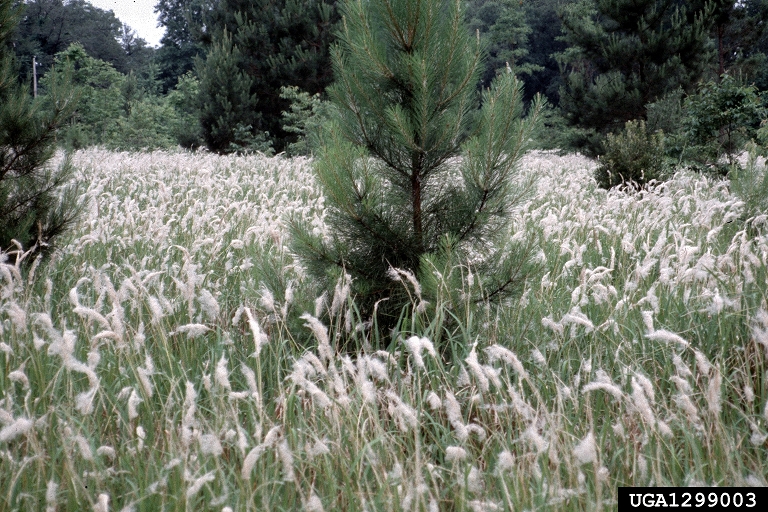
by Matt Lollar | Nov 4, 2021
Invasive species are all around us, from invasive plants like cogongrass to invasive amphibians like Cuban tree frogs to invasive insects like red imported fire ants. These species affect our ecosystems by outcompeting native species for nutrients or food and other precious resources. To help with the management of these noxious organisms, the October 2021 edition of Gardening in the Panhandle LIVE educated the public on invasive species. The highlights from the webinar are listed below.

Cogongrass dominating the landscape. Photo credit: Charles T. Bryson, USDA Agricultural Research Service, Bugwood.org.
Invasive Species Education
For general invasive species terminology please visit. Invasive Species Terminology: Standardizing for Stakeholder Education
Here’s a great resource to help educate the public about invasive plant species. Florida Invasive Plant Education Initiative
The University of Florida has developed a comprehensive list of invasive plant species. Assessment of Non-Native Plants in Florida’s Natural Areas
Invasive Species Control
Cogongrass Control: Cogongrass (Imperata cylindrica) Biology, Ecology, and Management in Florida Grazing Lands
Bamboo Control: Bamboo Control
Chinese Tallow (Popcorn Tree) Control: Natural Area Weeds: Chinese Tallow (Sapium sebiferum L.)
Armadillo Management: Baiting the Nine-Banded Armadillo
Dollarweed Control: Pennywort (Dollarweed) Biology and Management in Turf
Doveweed Control: Biology and Management of Doveweed (Murdannia Nudiflora) in Ornamental Crop Production
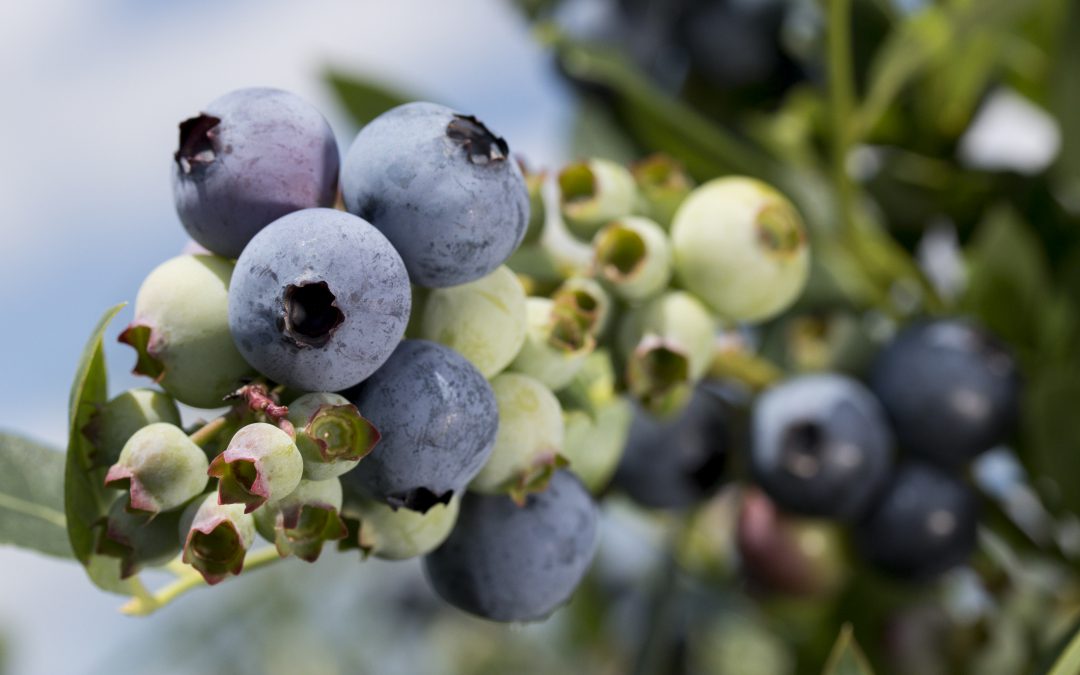
by Ray Bodrey | Jun 24, 2021
We have many choices of fruit that can be grown in the Florida Panhandle. For us hobby or dooryard growers, fruit trees can be an interesting crop to manage and most find it to be a beautiful addition to home landscapes. However, temperature and variety selection are key.
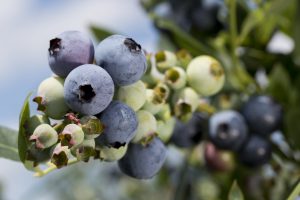
Blueberry Crop at UF/IFAS Plant Science Research & Education Unit. Photo Credit: Tyler Jones, UF/IFAS
Most fruit trees grown in the Panhandle are more temperate varieties, rather than tropical and subtropical fruits. Depending on the variety, winters in northern Florida may be too cold or may be too long for some fruit trees. Cold hardiness is a term used on fruit tree labels and reference guides. This refers to the plant’s ability to survive cooler or even freezing temperatures. In contrast, summer heat can also play a role in survivability. Some varieties are intolerant to excessive heat and humidity. The U.S. Department of Agriculture has developed a Plant Hardiness Zone Map that is helpful in selecting a variety of fruit tree: http://planthardiness.ars.usda.gov/PHZMWeb/. This is a standard by which gardeners and growers can determine which plants will thrive in their location. Northern Gulf County is in Zone 8b (15 to 20 degrees F), while coastal Gulf is in Zone 9a (20 to 25 degrees F).
Chilling requirement is another important topic when deciding on variety. Temperate zone fruit go through a “rest period” during the dormant months. For these fruit trees, a minimum length of time of cooler weather is needed for proper flowering to occur once favorable temperatures arrive. This rest period is essentially a reset. For the Panhandle, temperatures below 45 degrees F are known as chilling temperatures. The number of hours during the fall and winter that reach below this temperature equals the total chilling hours. For the Panhandle, this is rarely fewer than 500 hours. A plant that does not receive ample chilling will most likely be slow in bud and leaf development. Leaf expansion will be in increments throughout the year instead of in one period. On the other hand, colder, longer winters can cause fruit trees to end the rest stage early and begin to bud as soon as warmer temperatures arrive. This circumstance can cause cold injury later, as the Panhandle is historically known for late cold spells.
Citrus is a dooryard fruit, however it’s a subtropical fruit tree and not technically temperate. However, there are some varieties that thrive in the Panhandle. Another key to growing citrus, is to select varieties with different fruit maturity seasons. This way you can enjoy citrus year-round.
Some examples of dooryard fruit trees and varieties that are suitable for northern Florida are:
Apple: ‘TropicSweet’, ‘Anna’, ‘Dorsett Golden’
Blueberry: ‘Rabbiteye’, ‘Climax’, ‘Highbush’
Grapefruit: ‘Marsh’, ‘Ruby Red’
Lemon: ‘Myer’
Nectarine: ‘Suncoast’
Orange/Mandarin: ‘Navel’, ‘Parson Brown’, ‘Valencia’, Satsuma
Peach: ‘Gulfcrest’, ‘Gulfking’, ‘Gulfprince’
Pear: ‘Ayers’, ‘Baldwin’, ‘Kieffer’
Pecan: ‘Elliot’, ‘Stuart’, ‘Moreland’
So, where do I find information on varieties? The UF web publication “Dooryard Fruit Varieties” is a great resource. Also contact your local county extension office for more information.
Information for this article can be found in the UF/IFAS EDIS publication: “Dooryard Fruit Varieties” by J. G. Williamson, J. H. Crane, R. E. Rouse, and M. A. Olmstead: http://edis.ifas.ufl.edu/pdffiles/MG/MG24800.pdf
UF/IFAS Extension is an Equal Opportunity Institution.
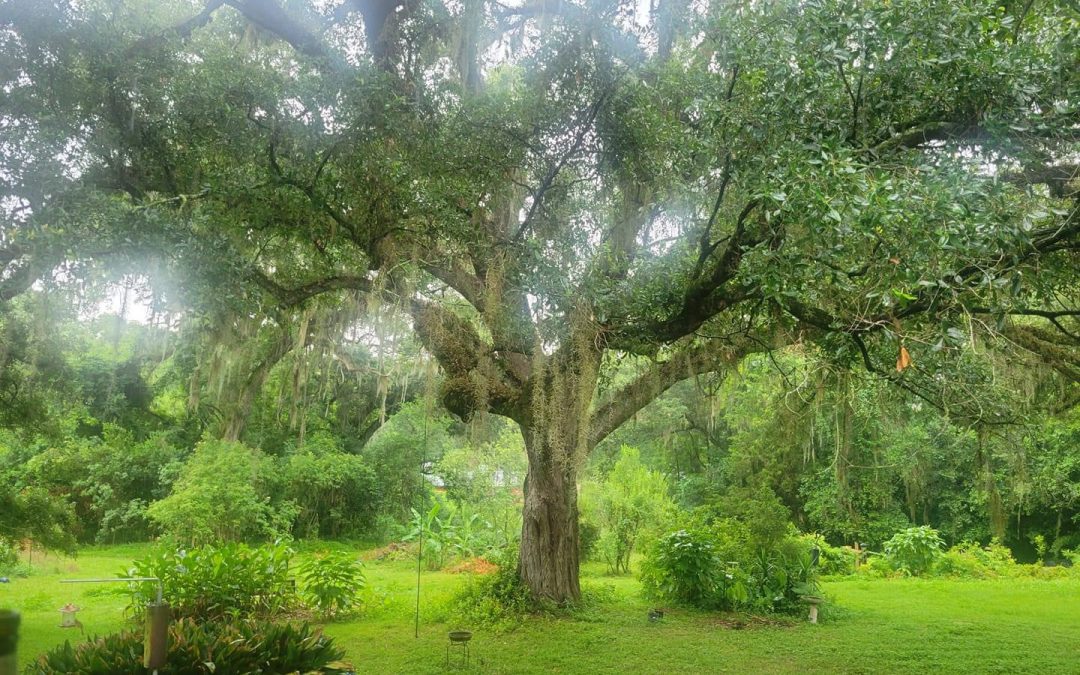
by Mark Tancig | Jun 17, 2021
Spending time outdoors during the Florida summer is not for the faint of heart. It’s hot! And it’s humid! Just moving around outside for a moment in the early morning causes you to break out in a sweat. Most evenings, even after the sun is low in the western sky, but there’s still enough light to enjoy the outdoors, the sweat doesn’t stop. A Floridian’s only hope is that nearby, there is a large shade tree to take cover under. In north Florida, there’s nothing more inviting than a huge live oak draped in Spanish moss for a drink of ice water and a slight breeze. If you don’t have such a spot, start thinking about planting a shade tree this winter!
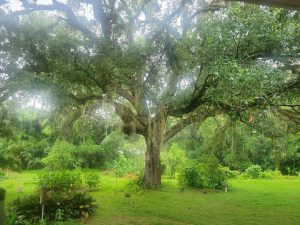
A large live oak is great for shade! Credit: Dawn Reed.
In north Florida, we have many options to choose from, as we live in an area of the United States with some of the highest native tree abundance. Making sure you get the right tree for the right place is important so make a plan. Where could this tree go? Is there plenty of space between the tree and any structures? You’ll want to give a nice shade tree plenty of room – 20’ to 60’ away from structures and/or from other large trees – to grow into a great specimen. Be sure not to place a large tree under powerlines or on top of underground infrastructure. You can “Call 811 before you dig” to help figure that out. If space is limited, you may want to consider trees that have been shown to be more resilient to tropical weather. Also try and place the tree in a way that provides added shade to your home. Deciduous trees planted along your home’s southeast to southwest exposure provide shade during the summer and let in the sun during the cooler winter. However, be careful that the tree doesn’t grow to block the sun from your vegetable garden!
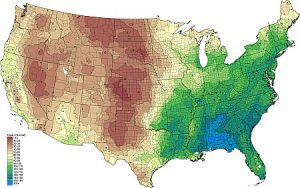
A density gradient map of native trees in the US. Notice where the highest number occur. Credit: Biota of North America Program.
Here are some ideas for shade trees, those trees that are tall (mature height greater than 50’) and cast a lot of shade (mature spread greater than 30’). All of these are native trees, which have the added benefit of providing food and shelter to native wildlife.
- Red maple (Acer rubrum)
- Pignut hickory (Carya glabra)
- Green ash (Fraxinus pennsylvanica)
- Tulip poplar (Liriodendron tulipifera)
- Southern magnolia (Magnolia grandiflora)
- Sycamore (Platanus occidentalis)
- Shumard oak (Quercus shumardii)
- Live oak (Quercus virginiana)
- American elm (Ulmus americana)
It’s best to plant during the winter and follow good planting practices.
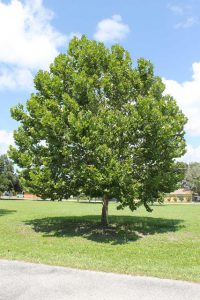
Even with this young sycamore, you’ll be made in the shade. Credit: UF/IFAS.
While it may take a while for you to relax under the shade of your tree, they can surprise you in their growth and, as they say, there’s no time like the present. If you have questions on selecting or planting shade trees, contact your local UF/IFAS Extension office.
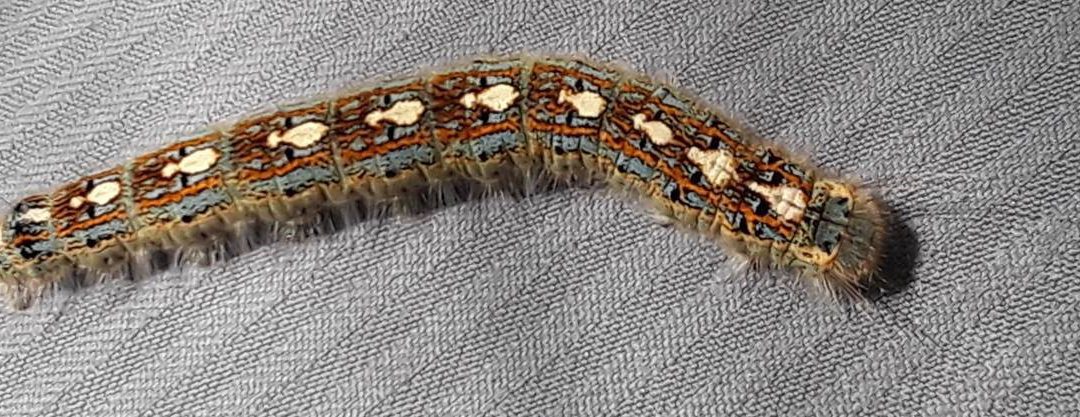
by Evan Anderson | May 20, 2021
A number of landowners in our region have been noticing a number of caterpillars coming down from the treetops. Sometimes appearing in vast numbers, the forest tent caterpillar has been found throughout Florida and the United States. Several years of heavy infestation occurred in Central Florida more than a decade ago, but populations are usually not high enough to cause significant damage to trees.
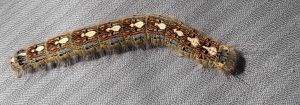
A forest tent caterpillar. – Photo courtesy of Shoal Sanctuary Nature Preserve.
The forest tent caterpillar is the larval stage of a somewhat nondescript brown moth. The moths lay their egg masses on twigs, and the eggs hatch in the spring. Caterpillars feed on a variety of tree species, but seem to prefer oak and gum trees. They spend anywhere from two to six weeks eating. When they are nearing maturity, they can become a problem for humans who do not appreciate the many droppings they produce, or their habit of descending from the trees to find places to spin their cocoons. They are sometimes attracted to lights or the walls of buildings, where they congregate in search of a place to pupate. They are not harmful to people, however.
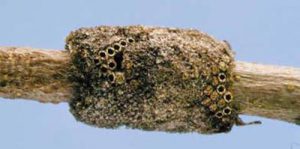
A forest tent caterpillar egg mass. – Photo courtesy of Jeffrey Lotz, Division of Plant Industry
Particularly cold winters may help decrease populations of these caterpillars. Inclement weather or high temperatures may do the same in the summer, and natural predators often help to control populations when present as well. Controlling forest tent caterpillars is most often unnecessary even when there are large numbers of them. It may help to avoid parking cars under large infestations or to turn off outdoor lighting that might attract them at night. If they wander indoors, check screens and window seals to be sure there are no gaps for them to enter.
If these or other caterpillars become such a nuisance that control measures must be considered, consider using a product such as Bacillus thuringiensis, or Bt, which specifically affects caterpillars and not other beneficial insects. Keep affected trees healthy with proper fertilization and watering, and even a defoliated tree will probably recover from any damage these insects cause. For more information, see our EDIS publication on the Forest Tent Caterpillar or contact your local Extension office.
-Evan Anderson, Walton County Horticulture Agent.
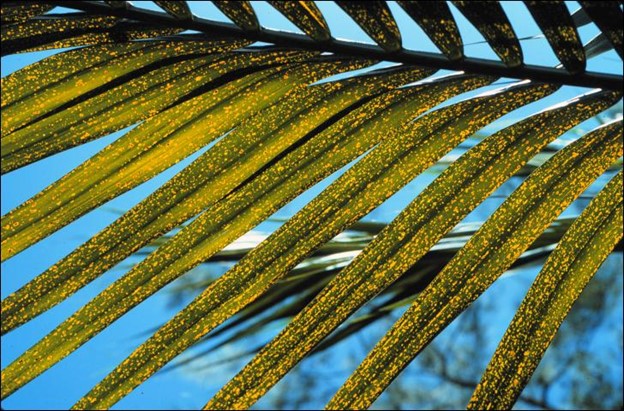
by Matt Lollar | May 13, 2021
Palm trees are great for adding a tropical feel to your landscape. For the most part, they are easy to care for, however there are a number of environmental and nutritional factors that can affect palm tree growth. Extended drought conditions can cause palm trunk to contract or shrivel and extended periods of moisture can cause trunks to swell and crack.
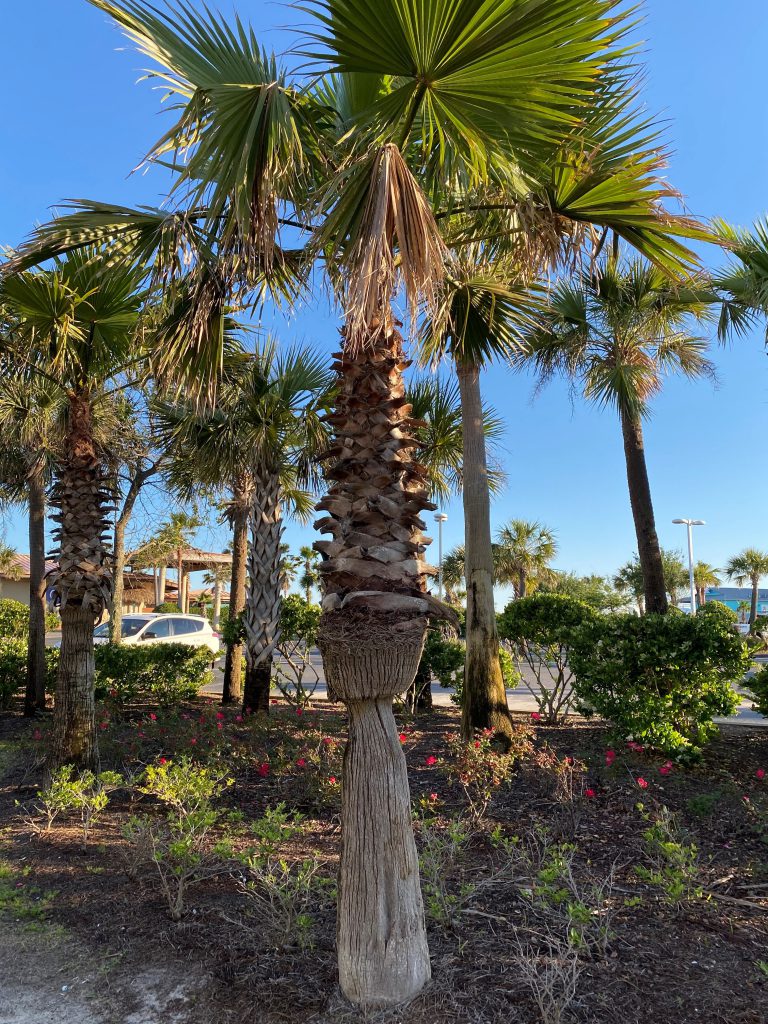
A palm tree with an irregularly shaped trunk due to water stress. Photo Credit: Matt Lollar, University of Florida/IFAS Extension – Santa Rosa County
Palm trees are monocots and do not have lateral meristems or vascular cambium. In dicot and coniferous trees these structures produce additional xylem (water transport structures) internally and phloem (nutrient transport structures) and bark externally. This means that once the apical meristem (frond producing portion of the palm) dies, the tree dies. It also means that wounds to the trunks of palms are visible for life instead of healing over like in dicots. If you were to cut the top out of a red maple, a number of it’s branches would fight to take over as the main trunk. If you were to cut the top out of a palm tree , you would be left with a dead snag for a tree. Palms certainly have unique structures and growing habits. Visit this publication from Dr. Timothy Broschat for more information on palm tree anatomy and morphology.
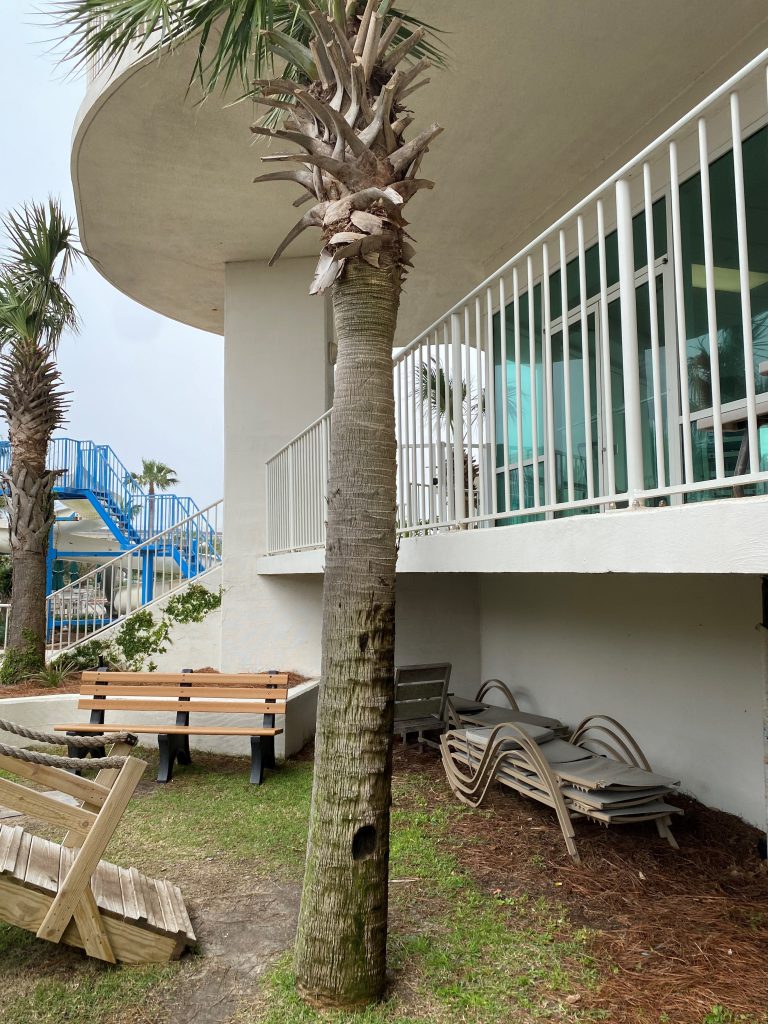
A palm tree with a wound near the base of its trunk. Photo Credit: Matt Lollar, University of Florida/IFAS Extension – Santa Rosa County
Palm trees display nutritional disorders differently from other trees. Their nutritional balance gets disrupted if too much nitrogen is applied. This often happens when high nitrogen turfgrass fertilizers are applied near palm plantings. The recommended palm fertilizer is 8-2-12 (nitrogen-phosphorus-potassium) plus 4 magnesium all available in 100% slow release form. A soil test is recommended to determine if other micronutrients are needed in addition to magnesium.

Potassium-deficient older leaf of Dictyosperma album (hurricane palm) showing translucent yellow-orange spotting. Photo Credit: Timothy K. Broschat, University of Florida/IFAS
Potassium is one of the most common nutrient deficiencies observed in palm trees. For more detailed information on palm tree nutrient deficiencies please visit the publication: Nutrient Deficiencies of Landscape and Field-Grown Palms in Florida.
This article provides just a glimpse of some of the common issues that affect palms. For more information on what could be going on with your palm trees and general palm tree care please visit Ask IFAS: Palm Care.














